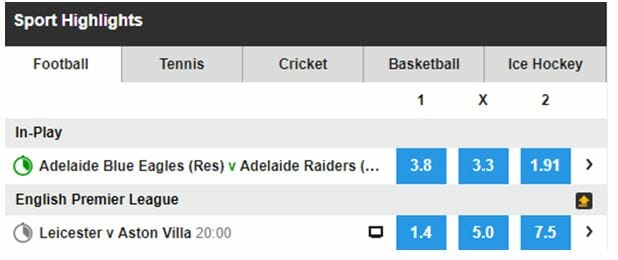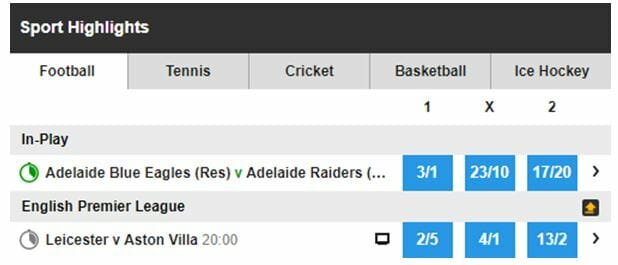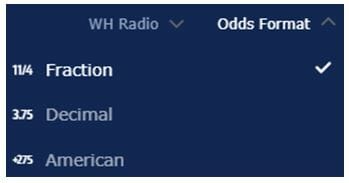When betting on sports, you can run into several types of odds such as are Fractional, Decimal, and American odds. While figuring out how much money you win from your bet should be easy enough, it is important to your betting strategy to know at what likelihood, in terms of percentages, bookies are estimating a win, loss, draw or any game statistic, prop or event. This article will teach you how to calculate the implied probability behind any type of odds and how to use it in your betting strategy.
- 1 The Punters Page Odds Calculator
- 2 What is Implied Probability?
- 3 Implied Probability
- 4 Implied Probability Chart
- 5 How to Calculate Implied Probability from Odds
- 6 Implied Probability versus Real Probability
- 7 How to Use Implied Probability in Your Betting strategy
- 8 Other Common Betting Terms
- 9 ThePuntersPage Final Say
- 10 Implied Probability FAQs
The Punters Page Odds Calculator
How To Use The Punters Page Odds Calculator
-
Choose your preferred odds format (Decimal, Fractional or American)
-
Insert the odds you wish to convert in the white box in the top right of the calculator.
-
The odds conversion for the other two types of odds together with the implied probability will be shown automatically.
Should you wish to use the Odds Calculator for a new conversion, simply tap the RESET button in green.
What is Implied Probability?
Every time the bookies working behind the various betting sites creates odds on an event, they first calculate the probability and decide how likely an event is. This is called “capping.” They have various strategies to do this, including reviewing statistics, tactical analysis or simply copying odds from other bookmakers. Then they create odds based on these estimated probabilities. As you can see, every set of odds implies a certain estimated probability. The probability behind the odds is what we call implied probability.
Example of Implied Probability
For example, a bet with odds of 3/1 (4.0) has an implied probability of 25%. This percentage means the bet is expected to win one in every four attempts.
If you believe that the bet should be winning one if every three attempts (which would imply odds of 2/1), then the odds of 3/1 represents value.
Furthermore, by backing more ‘value bets', you also have a better chance of increasing your Return on Investment.
Implied Probability
The implied probability formula is very simple; so much so that even a high school student could do it.
The following formula shows how to convert the odds ratio to probability:
Implied Probability = [Denominator / (Denominator + Numerator)]x 100%
For example for odds of 2/1, you would do the following maths:
1 ÷ (1 + 2) * 100 = 33.3%
Implied Probability Chart
We have also listed below some of the most popular odds along with their implied probability in this handy chart:
| Fractional Odds | Decimal Odds | IP |
|---|---|---|
| 1/5 | 1.20 | 83.3% |
| 1/4 | 1.25 | 80% |
| 1/2 | 1.50 | 66.7% |
| 3/4 | 1.75 | 57.1% |
| 1/1 | 2.00 | 50% |
| 6/4 | 2.50 | 40% |
| 2/1 | 3.00 | 33.3% |
| 3/1 | 4.00 | 25% |
| 5/1 | 6.00 | 16.7% |
| 10/1 | 11.00 | 9.1% |
| 20/1 | 21.00 | 4.8% |
| 50/1 | 51.00 | 2% |
| 100/1 | 101.00 | 1% |
| 500/1 | 501.00 | 0.2% |
| 1000/1 | 1001.00 | 0.1% |
How to Calculate Implied Probability from Odds
Let’s look at how to calculate implied probability from Fractional, Decimal, and American/Moneyline odds. Most sites let you choose between the three odd types.

Decimal Odds to Implied Probability
Decimal Odds are the easiest odds to understand, and make it simple to calculate your potential winnings. You will find these odds on all betting sites and they are the most popular odds globally and in Europe.

In this example, Leicester is a 1.4 favourite to win the match. Let’s calculate the implied probability from those odds.
The formula to convert Decimal Odds is:
Implied Probability = (1/ decimal odds) x 100%
Fill in the odds from the example and we get:
Implied Probability = (1/ 1.4) x 100%= 71.43%
That means the bookies estimate a Leicester win to be very likely, at a probability of 71.43%.
Fractional Odds to Implied Probability
Fractional Odds are the most commonly used odds in the UK. While they are slightly more complex to understand than decimal odds, they easily show you how much you can make depending on your bet size. The denominator (the number on the right) shows you how much you have to bet to win the numerator (the number on the right). For example, bet 1 unit to win 4 units.

Since we have already calculated this probability for a Leicester win, let’s look at the implied probability for a draw.
The formula to convert fractional odds is:
Implied Probability = [Denominator / (Denominator + Numerator)] x 100%
Fill in the odds from the example and we get:
Implied Probability = [1/ (1+4)] x 100% = 1/5 x 100% = 20%
That means the bookies estimate a draw to be unlikely, at a probability of 20%.
American Odds to Implied Probability
American Odds (also known as Moneyline Odds) are the most commonly used odds in the US, Mexico and Canada. They will either show you how many units you need to bet to win 100 units (favourites), or what your return on 100 units will be (underdogs). These show a minus for the favourite and a plus for the underdog. Since Betfair does not offer American odds, let’s take an example from William Hill instead.

In the example below:
-
You need to bet £238 to win an extra £100 if you bet on a home win for Leicester.
-
You need to bet £100 to win an extra £650 if you bet on an away win for Aston Villa.
Positive American Odds
Let’s calculate the implied probability behind an Aston Villa (+650) win. To do this, we will use the following formula. Note that there are two formulas, depending whether the odds are positive or negative.
The formula to convert positive American odds is:
Implied Probability =100 / (positive American odds + 100) x 100%
Fill in the odds from the example and we get:
Implied Probability =100 / (650 + 100) x 100% = 100/750 x 100% = 13.3%
That means the bookies estimate an Aston Villa to be very unlikely, at a probability of 13.3%.
Negative American Odds
Let’s also calculate the odds for negative American odds. We will do this for a Leicester win (-238).
The formula to convert negative American odds is:
Implied Probability = [Negative American odds / (Negative American odds + 100)]x 100
Fill in the odds from the example and we get:
Implied Probability = [238/ (238+100)] x 100% = 238/338 x 100% = 70.4%
That means the bookies estimate a Leicester to win at a probability of 70.4%.

Implied Probability versus Real Probability
In our example, we can see that both Betfair and William Hill actually offer very beneficial odds. How can we tell? Let’s add up the implied odds from the three match outcomes: home win, draw or away win (2/5 + 4/1 + 13/2). We have already calculated them above.
70.4% +20% +13.3% = 103.7%
That brings the total likelihood of all three events at slightly more than 100%, giving both bookies a margin of just 3.7% on this event. This proves that these odds are actually very juicy indeed, placing both William Hill and Betfair among of the best bookmakers around! Juicy odds mean odds with low Vigorish, which is what you should look for in any bookmaker.
Often, bookies will set their odds much lower than what their actual estimation of them is. In other words, the implied probability is more than the real probability. This gives them a higher profit margin, as the Implied Probability adds up to much more than 100%. This profit is also called Vigorish, or house edge.
How to Use Implied Probability in Your Betting strategy
If you take yourself seriously as a bettor, you will have a sound betting strategy, of which the number one aspect should be looking for value in bets.
Use this strategy to beat the bookies:
-
First, decide how likely you estimate an event.You can do this by using statistics, charts, tactical analysis or any other method, depending on your knowledge of the sport.
-
Next, see how likely the bookies see your outcome.
-
If you think an event is more likely than what bookies are implying with their odds, you may have found a value bet.
-
Betting on real value bets consistently is how you ultimately make a profit.
Check out our article on value betting in sports for further in-depth guidance on the subject!
Other Common Betting Terms
ThePuntersPage Final Say
Any sound betting strategy should involve calculating implied probability from your bookie's odds. It is also an essential part of looking for value, and recommended for anyone who wants to take sports betting seriously.
Implied Probability FAQs
To calculate odds from implied probability, use this formula: Odds =1/ (1-Implied probability) For example, for an implied probability of 25% you would get the following odds: Odds = 1/ (1-0.75) = 1/0.25 = 4.0
To find the percentage of chance, use this formula: Percentage = [Denominator / (Denominator + Numerator)] x 100 For example, for a chance of 3/1, you would do the following maths: Percentage = 1 ÷ (1 + 3) x 100 = 25%
To convert odds to percentage, use this formula: Percentage = [Denominator / (Denominator + Numerator)] x 100 For example, for odds of 2/1, you would do the following maths: Percentage = 1 ÷ (1 + 2) x 100 = 33.3%






